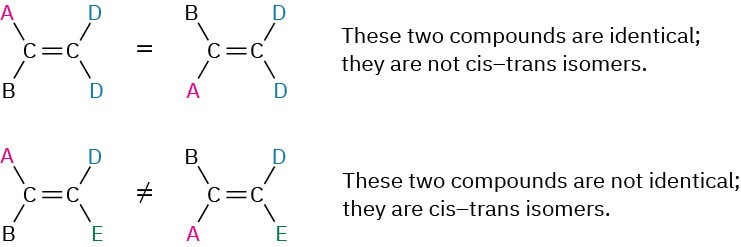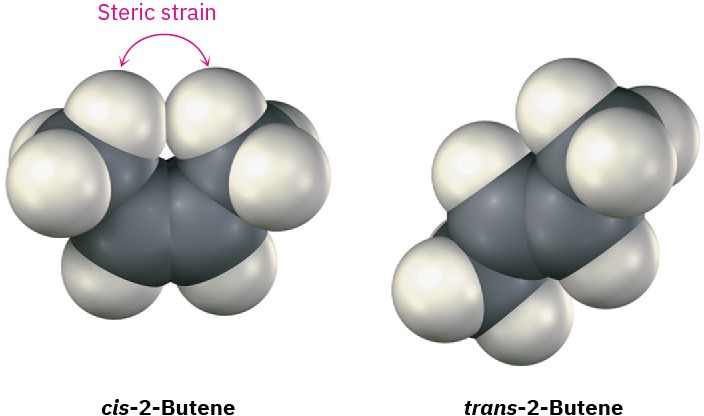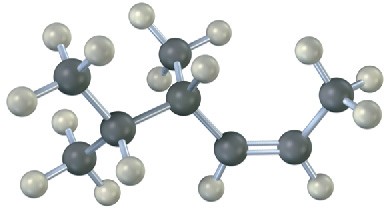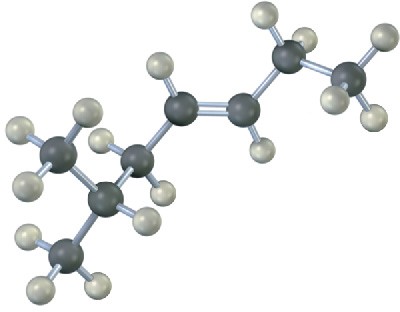4.3 Cis-Trans Isomers
The lack of rotation around carbon–carbon double bonds is of more than just theoretical interest; it also has chemical consequences. Imagine the situation for a disubstituted alkene such as 2-butene. (Disubstituted means that two substituents other than hydrogen are bonded to the double-bond carbons.) The two methyl groups in 2-butene can either be on the same side of the double bond or on opposite sides, a situation similar to that in disubstituted cycloalkanes (Section 2.9).
Since bond rotation can’t occur, the two 2-butenes can’t spontaneously interconvert; they are different, isolable compounds. As with disubstituted cycloalkanes, we call such compounds cis–trans stereoisomers. The compound with substituents on the same side of the double bond is called cis-2-butene, and the isomer with substituents on opposite sides is trans-2-butene (Figure 4.3).

Figure 4.3 Cis and trans isomers of 2-butene. The cis isomer has the two methyl groups on the same side of the double bond, and the trans isomer has methyl groups on opposite sides.
Cis–trans isomerism is not limited to disubstituted alkenes. It can occur whenever both double-bond carbons are attached to two different groups. If one of the double-bond carbons is attached to two identical groups, however, cis–trans isomerism is not possible (Figure 4.4).
 Figure 4.4 The requirement for cis–trans isomerism in alkenes. Compounds that have one of their carbons bonded to two identical groups can’t exist as cis–trans isomers. Only when both carbons are bonded to two different groups is cis–trans isomerism possible.
Figure 4.4 The requirement for cis–trans isomerism in alkenes. Compounds that have one of their carbons bonded to two identical groups can’t exist as cis–trans isomers. Only when both carbons are bonded to two different groups is cis–trans isomerism possible.
Although the cis–trans interconversion of alkene isomers does not occur spontaneously, it can often be made to happen by treating the alkene with a strong acid catalyst. If we interconvert cis-2-butene with trans-2-butene and allow them to reach equilibrium, we find that they aren’t of equal stability. The trans isomer is more stable than the cis isomer by 2.8 kJ/mol (0.66 kcal/mol) at room temperature, corresponding to a 76 : 24 ratio.

Cis alkenes are less stable than their trans isomers because of steric strain between the two larger substituents on the same side of the double bond. This is the same kind of steric interference that we saw previously in the axial conformation of methylcyclohexane (Section 2.14).
 Problem 4.7
Problem 4.7
Which of the following compounds can exist as pairs of cis–trans isomers? Draw each pair, and indicate the geometry of each isomer.
(a) CH3CH=CH2
(b) (CH3)2C=CHCH3
(c) CH3CH2CH=CHCH3
(d)(CH3)2C=C(CH3)CH2CH3
(e) ClCH=CHCl
(f) BrCH=CHCl
Problem 4.8
Name the following alkenes, including a cis or trans designation:
(a)

(b)


